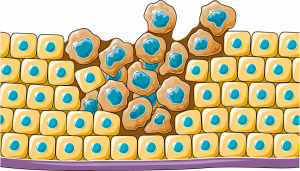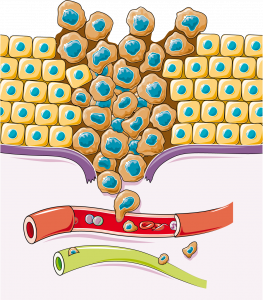2 1.1 Apoptosis & Cancer
Role of Apoptotic Mechanisms in Cancer
apoptosis
apə(p)ˈtəʊsɪs
n. The death of cells which occurs as a normal and controlled part of an organism’s growth or development[1]
Cell growth and division is propagated by the cell cycle. Deregulation of this cell cycle can lead to cell damage or excessive cell growth.
For a brief review of the different phases of the cell cycle please watch the video below:
Khan Academy: Cell Cycle Phases
To learn more about the M (Mitosis) phase of the cell cycle click on the the different parts below:

Errors in the cell cycle are often implicated in the development of cancerous tumors. These cancerous cells are dysfunctional in several ways, but one of the most dangerous mechanisms to be deregulated in cancer cells is apoptosis.
Apoptosis is programmed cell death resulting in removal of damaged cells. The deregulation of apoptotic mechanisms is a hallmark of cancers that can lead to excessive cell proliferation.

This excess cell proliferation can lead to cancers metastasizing throughout the body causing systemic damage.
The activation of anti-apoptotic factors or inactivation of pro-apoptotic factors contribute to the deregulation of apoptotic mechanisms. [3] Several different molecular pathways have been implicated in the regulation of apoptotic mechanisms, and almost all of them are currently being researched as potential targets for cancer treatments. [4]
- Apoptosis | Definition of Apoptosis by Lexico. Available at: https://www.lexico.com/en/definition/apoptosis. (Accessed: 30th November 2019) ↵
- Made with biorender.com ↵
- Pistritto, G., Trisciuoglio, D., Ceci, C., Alessia Garufi & D’Orazi, G. Apoptosis as anticancer mechanism: Function and dysfunction of its modulators and targeted therapeutic strategies. Aging 8, 603–619 (2016). ↵
- Pistritto, G., Trisciuoglio, D., Ceci, C., Alessia Garufi & D’Orazi, G. Apoptosis as anticancer mechanism: Function and dysfunction of its modulators and targeted therapeutic strategies. Aging 8, 603–619 (2016).; Ersahin, T., Tuncbag, N. & Cetin-Atalay, R. The PI3K/AKT/mTOR interactive pathway. Mol. Biosyst. 11, 1946–1954 (2015). ↵
